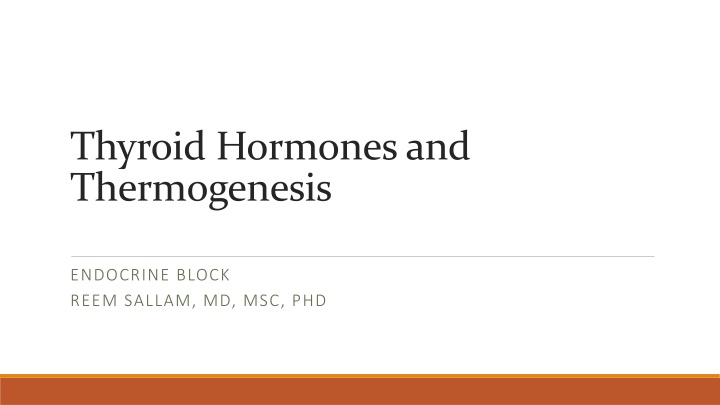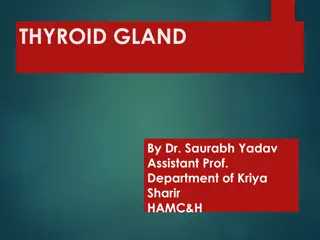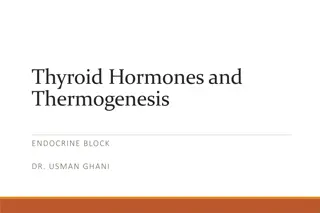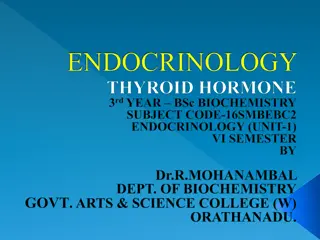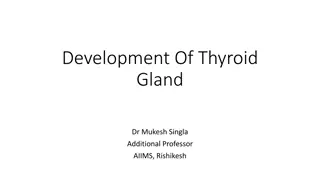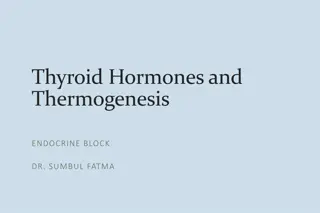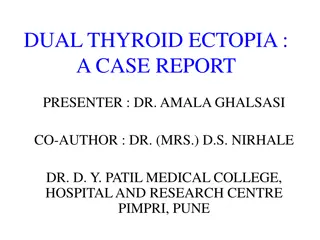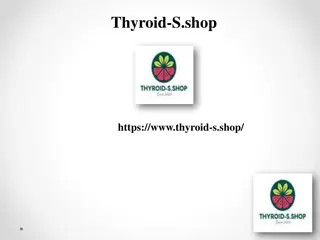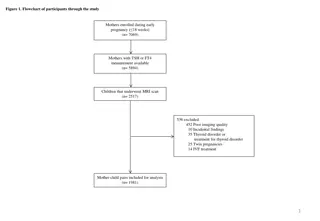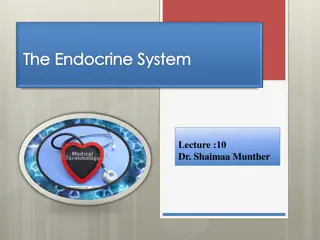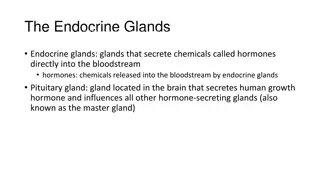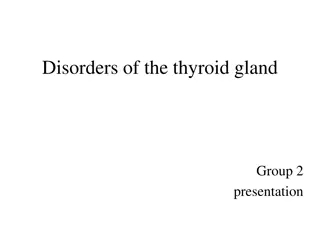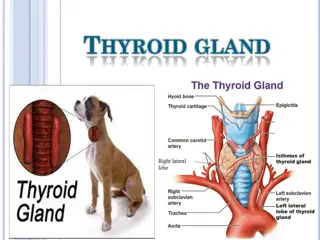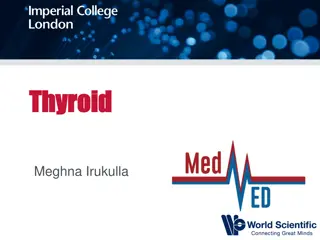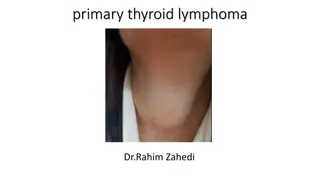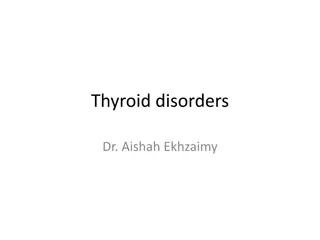Thyroid Hormones and Thermogenesis
Discuss the types, biosynthesis, actions, regulation, tests, and disorders of thyroid hormones, emphasizing thermogenesis and metabolic regulation. Includes images for better understanding.
Download Presentation

Please find below an Image/Link to download the presentation.
The content on the website is provided AS IS for your information and personal use only. It may not be sold, licensed, or shared on other websites without obtaining consent from the author.If you encounter any issues during the download, it is possible that the publisher has removed the file from their server.
You are allowed to download the files provided on this website for personal or commercial use, subject to the condition that they are used lawfully. All files are the property of their respective owners.
The content on the website is provided AS IS for your information and personal use only. It may not be sold, licensed, or shared on other websites without obtaining consent from the author.
E N D
Presentation Transcript
Thyroid Hormones and Thermogenesis ENDOCRINE BLOCK REEM SALLAM, MD, MSC, PHD
Objectives: By the end of this lecture, the students are expected to: 1. Describe types and steps of biosynthesis of thyroid hormones 2. Discuss the thyroid hormone actions 3. Determine different levels for the regulation of thyroid hormones 4. List the thyroid function tests 5. Define goiter 6. Differentiate between hypo and hyperthyroidism based on: 1. Causes 2. Diagnosis 3. Treatment 7. Discuss the concept of thermogenesis as it is linked to the thyroid hormone
Types & Biosynthesis of Thyroid Hormones Thyroxine (T4) and tri-iodothyronine (T3) Synthesized in the thyroid gland by: Iodination Coupling of two tyrosine molecules Attaching to thyroglobulin protein Thyroid gland mostly secretes T4 Peripheral tissues (liver, kidney, etc.) de-iodinate T4to T3 Deiodination is catalyzed by deiodinase enzymes
Thyroxine Thyroxine (T (T4 4), Tri Reverse T Reverse T3 3 (rR ), Tri- -iodothyronine iodothyronine (T (T3 3) & (rR3 3) ) ) & Plasma [T4]: 100 nmol/L Plasma [T3]: 2 nmol/L
Types & Biosynthesis of Thyroid Hormones, continued.. T3 is the more biologically active form T4 can be converted to rT3 (reverse T3) inactive form Most of T4 is transported in plasma as protein-bound Thyroxin Binding globulin (TBG)-bound (70%) Albumin-bound (25%) Transthyretin (prealbumin)-bound (5%) The unbound (free) form of T4 and T3 are biologically active
Thyroid hormone action Plays an essential role in maturation of all body tissues, coordinating development and specific cell functions Involved in thermogenesis and metabolic regulation Increases cellular oxygen consumption and stimulates the metabolic rate. Affects the rate of protein, carbohydrate and lipid metabolism
Thyroid Hormone Action, continued.. Clinical evidence of the wide spectrum of thyroid hormone action: Untreated congenital hypothyroidism permanent brain damage Hypothyroid children have: delayed skeletal maturation short stature delayed puberty Hypothyroid patients have high serum cholesterol due to: Down regulation of LDL receptors on liver cells Failure of sterol excretion via the gut
Regulation of Thyroid Hormone Secretion The hypothalamic-pituitary-thyroid axis regulates thyroid secretion The hypothalamus senses low levels of T3/T4 and releases thyrotropin releasing hormone (TRH) TRH stimulates the pituitary to produce thyroid stimulating hormone (TSH)
Regulation of Thyroid Hormone Secretion, continued.. TSH stimulates the thyroid to produce T3/T4 until levels return to normal T3/T4 exert negative feed back control on the hypothalamus and pituitary Controlling the release of both TRH and TSH
Regulation of Thyroid Hormone Secretion, continued.. High thyroid hormone levels suppress TRH & TSH Low thyroid hormone levels stimulate TRH & TSH to produce more hormone
Elements involved in Hypothalamic- Pituitary-Thyroid regulation 1. Hypothalamus nuclei Regulation of Trh gene transcription and processing Regulation in response to nutrient status 2. Pituitary: Regulation of TRH degradation Regulation of TSH synthesis and activation 3. Thyroid: Regulation of synthesis and release of T4 and its conversion to T3 by deiodinase 2 (D2) enzyme Patricia Joseph-Bravo et al. J Endocrinol 2015;226:T85-T100 60 Years Of Neuroendocrinology. TRH, the first hypophysiotropic releasing hormone isolated: control of the pituitary thyroid axis
Thyroid Function Tests (TFT) I. TSH measurement: Indicates thyroid status Sensitive, first-line test II. Total T4 or free T4: Indicates thyroid status Monitors thyroid treatment (both anti-thyroid and thyroid supplement treatment) During the early treatment of hyperthyroidism, TSH may take up to 8 weeks to adjust to new level during treatment.
Thyroid Function Tests (TFT), continued.. III. Total T3 or free T3: Rise in T3 is independent of T4 In some patients only T3 rises (T4 is normal): T3 toxicosis For earlier identification of thyrotoxicosis IV. Antibodies: Diagnosis and monitoring of autoimmune thyroid disease (Hashimoto s thyroiditis); anti-thyroid peroxidase in hypothyroidism Diagnosis of Grave s disease: Antibodies against TSH receptors on thyroid cells
Goitre, Hypo and Hyperthyroidism Enlarged thyroid gland Functionally; Goitre may be associated with: Hypofunction Hyperfunction Normal concentration of thyroid hormones (euthyroid) Causes: Iodine deficiency Selenium deficiency Hashimoto s thyroiditis Graves disease (hyperthyroidism) Congenital hypothyroidism Thyroid cancer
Hypothyroidism Deficiency of thyroid hormones Primary hypothyroidism: Failure of thyroid gland Secondary hypothyroidism: Failure of the pituitary to secrete TSH (rare) Failure of the hypothalamic-pituitary-thyroid axis
Hypothyroidism, continued.. Causes: Hashimoto s disease Radioiodine or surgical treatment of hyperthyroidism Drug effects TSH deficiency Congenital defects Severe iodine deficiency Clinical features Tiredness Cold intolerance Weight gain Dry skin
Hypothyroidism, continued.. Non-thyroidal illness In some diseases, the normal regulation of TSH, T3 and T4 secretion and metabolism is disturbed Most of T4 is converted to rT3 (inactive) Causing thyroid hormone deficiency Secretion of T4 and T3 is decreased
Hyperthyroidism Over-activity of the thyroid gland secretion of thyroid hormones Tissues are exposed to levels of thyroid hormones (thyrotoxicosis) pituitary stimulation of the thyroid gland Causes: Grave s disease Toxic multinodular goitre Thyroid adenoma Thyroiditis Intake of iodine / iodine drugs Excessive intake of T4 and T3
Hyperthyroidism, continued.. Clinical features: Weight loss with normal appetite Sweating / heat intolerance Fatigue Palpitation / agitation, tremor Angina, heart failure Diarrhea Eyelid retraction and lid lag
Graves Disease Most common cause of hyperthyroidism An autoimmune disease Antibodies against TSH receptors on thyroid cells mimic the action of pituitary hormone
Hyperthyroidism, continued.. Diagnosis Suppressed TSH level Raised thyroid hormones level Confirms primary hyperthyroidism Problems in diagnosis Total serum[T4] changes due to changes in binding protein levels In pregnancy, high estrogens increase TBG synthesis Total [T4] will be high, free [T4] will be normal
Hyperthyroidism, continued.. Congenital TBG deficiency can also influence results Free T4 and TSH are first-line tests for thyroid dysfunction Treatment Antithyroid drugs: carbimazole, propylthiouracil Radioiodine: sodium 131I inhibits T4/T3 synthesis Surgery: thyroidectomy
Thermogenesis (Heat production) Thermogenesis (Heat production) Humans are homeothermic (keeping a constant body temperature, independent of the environment) This is achieved by a tight control of our bodies temperature homeostasis Heat production (Thermogenesis) is of 2 types: Obligatory: Basic heat production due to basal metabolic rate Facultative: On-demand extra heat production from metabolic activity in brown adipose tissue (BAT) and skeletal muscle. In BAT, facultative thermogenesis is stimulated by sympathetic nervous system in response to cold temperature
Sites of thyroid hormone regulation of metabolism 1 Hypothalamus-Pituitary- Thyroid Axis In response to feedback regulation, nutrition status and stress level regulation of TRH, TSH, and T4 release and central conversion of T4 toT3 2 BAT In response to sympathetic nervous system and bile acids D2 UCP1 & thermogenesis and body weight 6 Pancreas local T3 effect on cell function & proliferation local T3 In response T4 4 5 Liver 3 Muscle WAT In response to lipolysis in WAT effect on cholesterol and lipid metabolism and synthesis and release of Bile acid In response T4 and to bile acid D2 & local T3 energy expenditure In response to sympathetic nervous system T3 lipolysis & body fat local Mullur et al, Physiol Rev. 2014 Thyroid Hormone Regulation of Metabolism
Thyroid Hormone and Thermogenesis in Thyroid Hormone and Thermogenesis in homeothermic homeothermic species species Thyroid hormone has an essential role in thermogenesis: 1- Obligatory thermogenesis: ~ 30% of obligatory thermogenesis depends on thyroid hormone which is essential for temperature homeostasis 2- Facultative thermogenesis: in the absence of thyroid hormone, the thermogenic response of BAT is substantially reduced
The Mechanisms by which Thyroid Hormone Regulates Thermogenesis B The energy is then transferred from ATP to provide energy for biological processes A The energy released from substrate oxidation is captured in ATP A fraction of the energy involved both in the synthesis of ATP and in its consumption is lost as heat Thyroid hormone increases heat production by: increasing ATP utilization reducing the thermodynamic efficiency of ATP synthesis Silva, Ann Intern Med. 2003;139:205-213: The Thermogenic Effect of Thyroid Hormone and Its Clinical Implications
Mechanism of action of uncoupling proteins (UCPs): Example: UCP1 is present in the inner mitochondrial membrane of BAT. Other UCPs are ubiquitous The energy released in the oxidation of substrates in the mitochondria proton gradient The energy accumulated in this gradient is used the ATP Synthase to produce ATP i.e. oxidation is coupled to phosphorylation UCPs reduce the proton gradient, bypassing the ATP synthase protons down the gradient heat (because oxidation is uncoupled to phosphorylation) exothermic movement of Silva, Ann Intern Med. 2003;139:205-213: The Thermogenic Effect of Thyroid Hormone and Its Clinical Implications
Take home message Thyroid hormones include T4 , T3, and rT3 (which is inactive), they are synthesized by iodination, coupling and attaching to thyroglobulin protein. T3 is the active form of thyroid hormone and is synthesized by deiodinase in peripheral and central tissues. Thyroid hormone has wide spectrum of actions, for instance maturation of all body tissues, coordinating development and specific cell functions, metabolic regulation, and thermogenesis. Thyroid hormone is regulated by feed back mechanism. Several elements are involved in the regulation at the level of the hypothalamic nuclei, pituitary gland, thyroid, and peripheral tissues. TFT include measurement of TSH, total and free T4, total and free T3, and thyroid antibodies.
Take home message Goiter is and enlarged thyroid gland, that can be associated with: Hypo-, Hyper, or Eu (normal) thyroid function Hypo and hyperthyroidism are differentiated based on their clinical picture, causes, diagnostic criteria, and treatment Thyroid hormone regulates both obligatory and facultative thermogenesis. It increases obligatory thermogenesis, by accelerating ATP turnover and reducing the efficiency of ATP synthesis It increases facultative thermogenesis as it is necessary for an efficient response of BAT to cold
